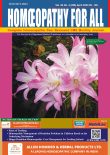The Homeopathic Approach to Drug-Induced Liver Injury
Keywords:
acetaminophen (Paracetamol), constitutionAbstract
Drug-induced liver injury (DILI), a significant concern in modern medicine, is commonly caused by hepatotoxic medications such as acetaminophen (Paracetamol). It can manifest as either acute or chronic liver damage, leading to symptoms like jaundice, fatigue, abdominal pain, nausea, and alterations in urine and stool color. While conventional treatments for DILI focus primarily on the withdrawal of the offending drug and supportive care, these approaches are often insufficient, as there are limited specific antidotes available for most cases. This necessitates the exploration of non conventional treatment options like homeopathy to address the root causes of DILI effectively. Acetaminophen, the most frequent cause of DILI, has been widely studied for its hepatotoxic effects. Research has shown that homeopathic drugs like Carduus marianus and Chelidonium majus, with their potential to prevent paracetamol induced centrilobular necrosis, vacuolization & macro-vesicular fatty changes, inflammation, and elevated serum markers like SGOT, SGPT, bilirubin, etc., may offer significant hepatoprotective benefits. These remedies work by counteracting macromolecular
Downloads
References
1. Rajamanickam Kandasamy, Sunny Mathew. Effect of Carduus marrianus and Chelidonium majus in hepatic damage. Int J Hom Sci 2021;5(1):213-217. DOI: 10.33545/26164485.2021.
v5.i1d.316
2. Hartmut Jaeschke, Anup Ramachandran, Comments on: Unveiling the therapeutic promise of natural products in alleviating drug‐induced liver injury: Present advancements and future prospects, Phytotherapy Research, 10.1002/ptr.8145, 38, 4, (1781- 1782), (2024).
3. Theruvath AH, Raveendran R, Philips CA. Dangerous Placebo During the COVID-19 Pandemic: A Series of Homoeopathic Arsenicum Album-Induced Liver Injury. Cureus. 2022;14(6):e26062. Published 2022 Jun 18. doi:10.7759/cureus.26062
4. Nayak D, Chaudhary A, Arora I, Varanasi R. Arsenicum album 30C: An Unlikely Source of Liver Toxicity. Homeopathy. 2023 Nov;112(04):288-90.
5. Kent, J. T. (1900). Lectures on Homoeopathic Philosophy. India: Indian Books & Periodicals Publishers.
6. Hahnemann, Samuel. Organon of Medicine 5 and 6 Edition.
India, B. Jain Publishers Pvt. Limited, 2013.
7. Valavan R, et. al. A Compendium of Rare and Clinically Established Mother Tinctures, 6th Edition, Dr. Willmar Schwabe India, Pvt. Ltd., A-36, Sector 60, Noida
8. Nachar, A., Saleem, A., Arnason, J. T., & Haddad, P. S. (2015). Regulation of liver cell glucose homeostasis by dehydroabietic acid, abietic acid and squalene isolated from balsam fir (Abies balsamea (L.) Mill.) a plant of the Eastern James Bay Cree traditional pharmacopeia. Phytochemistry, 117, 373-379.
9. Chua, L. S. (2014). Review on liver inflammation and antiinflammatory activity of Andrographis paniculata for hepatoprotection. Phytotherapy Research, 28(11), 1589-1598.
10. Yasin, Y. S., Hussian, S. M., & Rahem, S. M. (2017). Antibacterial activity of ethanolic extract of leaves of the blessed thistle (Cnicus
benedictus L.). Al Mustansiriyah Journal of Pharmaceutical Sciences, 17(1), 9-9.
11. Figueiredo, M. B. G. D. A., Santana, V. R. D., Nardelli, M. J., Nogueira, M. D. S., Azevedo, D. X., Santana, D. P. A., ... & Lima, S. O. (2016). The effect of the aqueous extract Peumus boldus on the proliferation of hepatocytes and liver function in rats submitted to expanded hepatectomy. Acta Cirúrgica Brasileira, 31(9), 608-614.
12. W. Boericke, New Manual of Homoeopathic Materia Medica & Repertory [with Relationship of Remedies], Second Re
Augmented & Revised Edition Based on Ninth Edition, Reprint Edition 2002, B. Jain Publishers, New Delhi.
13. Winston, D. (1992). Nvwoti, Cherokee medicine and ethnobotany. American Herbalism, The Crossing Press, Freedom, CA.
14. Sikdar, S., & Khuda-Bukhsh, A. R. (2013). Post-cancer
treatment of Condurango 30C, traditionally used in homeopathy, ameliorates tissue damage and stimulates reactive oxygen species in benzo [a] pyrene-induced lung cancer of rat. CellMed, 3(3), 25-1.
15. Xu, W., Zhu, H., Hu, B., Cheng, Y., Guo, Y., Yao, W., & Qian, H. (2021). Echinacea in hepatopathy: A review of its phytochemistry, pharmacology, and safety. Phytomedicine, 87, 153572.
16. J. H. Clarke, Dictionary of Practical Materia Medica, Reprint Edition 1992, B. Jain




